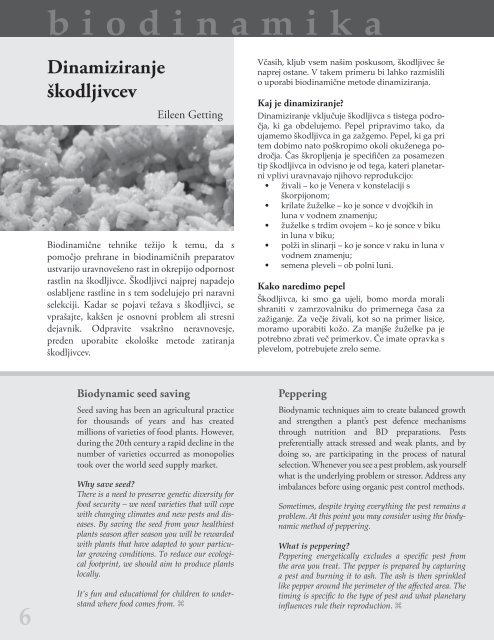You also want an ePaper? Increase the reach of your titles
YUMPU automatically turns print PDFs into web optimized ePapers that Google loves.
i o d i n a m i k a<br />
Dinamiziranje<br />
škodljivcev<br />
Eileen Getting<br />
Biodinamične tehnike težijo k temu, da s<br />
pomočjo prehrane in biodinamičnih preparatov<br />
ustvarijo uravnovešeno rast in okrepijo odpornost<br />
rastlin na škodljivce. Škodljivci najprej napadejo<br />
oslabljene rastline in s tem sodelujejo pri naravni<br />
selekciji. Kadar se pojavi težava s škodljivci, se<br />
vprašajte, kakšen je osnovni problem ali stresni<br />
dejavnik. Odpravite vsakršno neravnovesje,<br />
preden uporabite ekološke metode zatiranja<br />
škodljivcev.<br />
Včasih, kljub vsem našim poskusom, škodljivec še<br />
naprej ostane. V takem primeru bi lahko razmislili<br />
o uporabi biodinamične metode dinamiziranja.<br />
Kaj je dinamiziranje?<br />
Dinamiziranje vključuje škodljivca s tistega področja,<br />
ki ga obdelujemo. Pepel pripravimo tako, da<br />
ujamemo škodljivca in ga zažgemo. Pepel, ki ga pri<br />
tem dobimo nato poškropimo okoli okuženega področja.<br />
Čas škropljenja je specifičen za posamezen<br />
tip škodljivca in odvisno je od tega, kateri planetarni<br />
vplivi uravnavajo njihovo reprodukcijo:<br />
• živali – ko je Venera v konstelaciji s<br />
škorpijonom;<br />
• krilate žuželke – ko je sonce v dvojčkih in<br />
luna v vodnem znamenju;<br />
• žuželke s trdim ovojem – ko je sonce v biku<br />
in luna v biku;<br />
• polži in slinarji – ko je sonce v raku in luna v<br />
vodnem znamenju;<br />
• semena pleveli – ob polni luni.<br />
Kako naredimo pepel<br />
Škodljivca, ki smo ga ujeli, bomo morda morali<br />
shraniti v zamrzovalniku do primernega časa za<br />
zažiganje. Za večje živali, kot so na primer lisice,<br />
moramo uporabiti kožo. Za manjše žuželke pa je<br />
potrebno zbrati več primerkov. Če imate opravka s<br />
plevelom, potrebujete zrelo seme.<br />
6<br />
Biodynamic seed saving<br />
Seed saving has been an agricultural practice<br />
for thousands of years and has created<br />
millions of varieties of food plants. However,<br />
during the 20th century a rapid decline in the<br />
number of varieties occurred as monopolies<br />
took over the world seed supply market.<br />
Why save seed?<br />
There is a need to preserve genetic diversity for<br />
food security – we need varieties that will cope<br />
with changing climates and new pests and diseases.<br />
By saving the seed from your healthiest<br />
plants season after season you will be rewarded<br />
with plants that have adapted to your particular<br />
growing conditions. To reduce our ecological<br />
footprint, we should aim to produce plants<br />
locally.<br />
It’s fun and educational for children to understand<br />
where food comes from. <br />
Peppering<br />
Biodynamic techniques aim to create balanced growth<br />
and strengthen a plant’s pest defence mechanisms<br />
through nutrition and BD preparations. Pests<br />
preferentially attack stressed and weak plants, and by<br />
doing so, are participating in the process of natural<br />
selection. Whenever you see a pest problem, ask yourself<br />
what is the underlying problem or stressor. Address any<br />
imbalances before using organic pest control methods.<br />
Sometimes, despite trying everything the pest remains a<br />
problem. At this point you may consider using the biodynamic<br />
method of peppering.<br />
What is peppering?<br />
Peppering energetically excludes a specific pest from<br />
the area you treat. The pepper is prepared by capturing<br />
a pest and burning it to ash. The ash is then sprinkled<br />
like pepper around the perimeter of the affected area. The<br />
timing is specific to the type of pest and what planetary<br />
influences rule their reproduction.
















